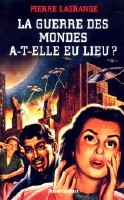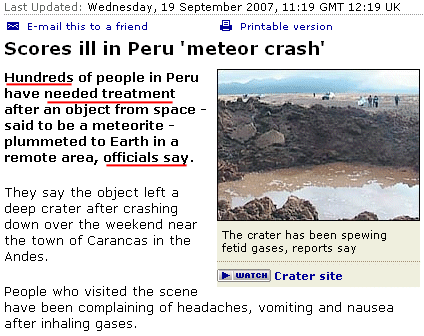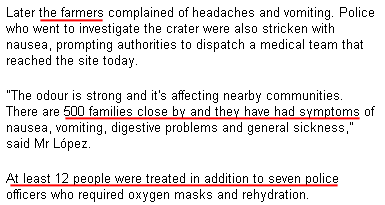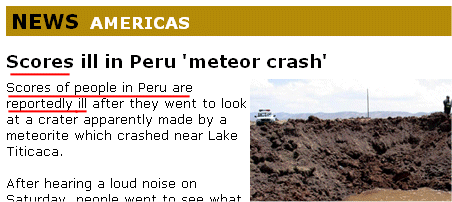Some proponents of the socio-psychological thesis - a thesis that claims that all UFO sighting reports are hoaxes and confusions - found their thesis, among other points, on the concept of mass hysteria that they say strikes people, considered as irrational crowds.
One such alleged case on which they sometimes rest their case for mass hysteria is the famous Orson Welles radio hoax, when on October 30, 1938, he had adapted to radio format an H.G. Wells novel, changed into false news bulletins telling "live" the invasion of the Earth by Martians. When reading later comments, it seems that the radio show had caused a huge panic all over the United States. More serious researchers discovered that the alleged panic had been completely exaggerated, that there was no real evidence of this alleged panic, that there was for example no mass suicides etc.

|
In France, the first researcher to have explained in detail how this alleged example of panic in hysterical crowds was in itself a hoax, a myth built by people posing as rational people, was Pierre Lagrange, in 2005, with his book "La Guerre des Mondes A-T-Elle Eu Lieu" (Did the War of the Worlds really happen?"), Robert Laffont publisher.
In September 2007, interesting events from this point of view took place, in Peru.
It starts with media reports on September 19, 2007, such as for example on the British TV news channel BBC News, as seen on their website:
They tell that hundreds of people in Peru needed treatment after a space object fell; which is "said" to be a meteorite, fallen on the ground, according to the officials.

|
The news of the of the meteorite fall is very largely spread in the entire world, accompanied by claims of ill people, a dozen, scores, then 200, then 300, then 600 people who are claimed to have been sick or had required treatment.
On the website of the newspaper "The Guardian", we are told that "at least 12 people" treated in addition to "seven policemen."

|
Source: http://www.guardian.co.uk/space/article/0,,2171920,00.html
On the British Press Association, we read that "many", "dozens", fell sick:

|
Source: http://ukpress.google.com/article/ALeqM5iaA2lfejT6gOouu5lelM45YDbgiQ
On the website of the Aljazeera TV channel, we read that "scores" of people are reportedly sick.

|
Source: http://english.aljazeera.net/NR/exeres/068F8143-E571-4A10-8BA1-EF7CD031F340.htm
On the site web of an Chinese information agency, we learn that "200 people" are sick:
|
|
Source: http://news.xinhuanet.com/english/2007-09/19/content_6754589.htm
On the website of the "Telegraph", we learn that "hundreds" of people are sick:

|
Source: http://www.telegraph.co.uk/news/main.jhtml?xml=/news/2007/09/19/wperu119.xml
Via CBS News, Canada, we climb to 600 sick people!

|
Source: http://www.cbc.ca/world/story/2007/09/19/peru-meteorite.html?ref=rss
On BBC radio, the morning of September 20, a journalist makes a connection between this incident and the Orson Wells Martian Invasion hoax...
Better still, in certain reports, there no was meteorite, it is a mistake!
http://news.bbc.co.uk/2/hi/americas/7001897.stm :
"Increasingly we think that people witnessed a fireball, which are not uncommon, went off to investigate and found a lake of sedimentary deposit, which may be full of smelly, methane rich organic matter," said Dr Caroline Smith, a meteorite expert at the London-based Natural History Museum.
"This has been mistaken for a crater."
A team of scientists is on its way to the site to collect samples and verify whether it was indeed a meteorite.
But we then get at http://ca.news.yahoo.com/s/capress/070919/world/peru_meteorite_2 :
Jose Mechare, a scientist with Peru's Geological, Mining and Metallurgical Institute, said Wednesday a geologist confirmed it was a "rocky meteorite," based on the fragments analyzed.
He said water in the meteorite's muddy crater boiled for maybe 10 minutes from the heat and could have given off a vapour that sickened people and scientists are taking water samples.
"We are not completely certain that there was no contamination," Mechare said.
The meteorite fall was commented on. It was first of all a question of finding out whether it is indeed a case of meteorite fall, or if it could be space junk, from a satellite or rocket, or... something else.
Very quickly, with the appearance of more detailed reports such that of the AFP, with the appearance of photographs or videos of the crater, it became obvious that yes, it was a meteorite fall, rather remarkable when the size of the crater is considered!
And very quickly, too quickly, something "obvious" surfaced...
These hundreds of sick people must be sick only in their imaginations...
Mass hysteria!
For example, I was told about the event:
"For additional information and concerning the disorders of the "witnesses", this is a phenomenon known under the name of "mass sociogenic illness" (MSI) or "mass psychogenic illness". (That often starts with an unpleasant sensory stimulus which causes real complaints with sensitive people.)
Really?
I must admit to myself that Pierre Lagrange's book was not read, or not understood.
Pierre Lagrange described that there is a mechanism of rumour at the origin of the notion of "hysterical crowds", these irrational crowds who commit suicides, run screaming in pajamas in the streets, fall sick... over nothing, by mass hysteria, autosuggestion.
Lagrange explained how in this sort of cases, if one wants to give himself the trouble of thoroughly checking about the so called mass hysteria, it appears that very often it is mainly fabricated by the news media anf then serves as evidence in the circles that promote themselves as "rationalists" to put out the claim that people are caught in mass hysteria, people are irrational, wheras they know better, they are rational...
Well, since I have read Pierre Lagrange's book, which offers many documented examples of the process by which the skeptic mythology of the irrational crowds was built, I understood that I had right under the eyes, with the case of meteorite fall, a perfect opportunity, a "live" opportunity, a situation where I could verify whether crowds are irrational or not. Checking into this event should indeed result in either one more example of the intellectual fallacy of the construction of the concept of mass hysteria or on the contrary a fine example of mass hysteria.
Checking into this is two-fold.
1) Is it even possible to "get sick" for real because a meteorite fell?
Yes it is! The fall can clear grounds containing sulphur or sulphuric or methanoid or other natural gases, to release relatively toxic gases due to the fusion of the rocks, which over there can be volcanic, release a nauseous odor, irritate throats, cause dizzyness and headaches. Real symptoms, and not imaginary symptoms, from real causes and not imaginary causes!
It is thus from this point of view actually possible that people present symptoms following the fall of this meteorite, a relatively large meteorite, causing an impressive 30 meters diameter crater, 6 meters of deep, in grounds that can actually be loaded of enough toxic natural substances to cause these symptoms.
Concern is then perfectly justified, the symptoms also, and then, there is no hysteria in this!
2) But is this even true that so many people reported sick and had to be treated?
With rigour, it is actually this claim that should be checked first, before even trying to establish if sickness can be caused by a meteorite fall or can only be mass hysteria.
Normally, a researcher adopting the skeptic stance, or claiming rationalism, should be the first to know that before analyzing a reported event, before trying to draw some conclusions, it must first be checked whether the reported event even occurred in the first place, and to check if it was truthfully reported!
At the beginning of this article, I show, with the evidence to support it, that what started with "many" patients, or "12 sick farmers and 7 police officers", soone changes in the news headlines into "dozens" of sick people, then "scores", then "200 sick", "hundreds", up to "600 hundreds"!
How can anyone not see in all this exactly the mechanism exposed by Pierre Lagrange? That of the instantly growing rumour and the excited sensationnalism of the media?
How is it that people from so-called skeptic circles, claiming scepticism, avid critics of media sensationnalism in certain circumstances, do not feel any need for any verification when the "news" seem to cinfirm their world vision?
Indeed, in such an event, "at the other end of the world" for French, English, Chinese commentators, isn't it rather advisable to check for example the local sources as a first step?
From Yahoo News Canada:
But they are still puzzling over claims it gave off fumes that sickened 200 people.
[...]
But a team of doctors who reached the isolated site said Wednesday they found no evidence the meteorite had sickened people.
Source: http://ca.news.yahoo.com/s/capress/070919/world/peru_meteorite_2
Different already, isn't it?
The report from the first local source I found.
This appeared in the El Commercio newspaper, Lima, Peru, for September 19:
They deny any trace of radioactivity for the population close to the impact area. The physical dizzyness of peasants would be with other health problems.
By Carlos Fernández Baca
A group of experts from the the Geological, Mettalurgy and Mining Institute, and teachers of the National University of the Altiplano confirmed yesterday that what fell last Saturday in the country community of Carancas, sector of Desaguadero, was a space meteorite and not space junk, as was also speculated.
The specialists used a Geiger counter, which allowed to discard any trace of radio-radioactivity in the populated zone. According to Mario Bosquet Godoy, chief of this team of scientists, there was no radioactivity and he was able to specify that the crater of Carancas was produced by a meteorite of the rocky type.
Nuclear physicist Modesto Montoya, member of the National Academy of Sciences, also shares this assertion: "the meteorites have a low amount of radioactivity, which can in no way harm the population close to the place where they fall. I do not know any reports indicating irradiation of people exposed to a meteorite", said the scientist.
A team of nine doctors of the Regional Management of the Public Health of Puno also arrived at the area to evaluate the health of the residents who complained about nausea, headaches and vomiting after the fall of the meteorite.
Evidence of radioactivity was not found there, but blood samples of 19 people were taken to discard other troubles. These samples will be sent in Lima for the corresponding analysis.
According to Modesto Montoya, the dizzyness could have been caused by the fear which was produced by the fall of the meteorite. "When a meteorite falls, it produces terrible sounds while coming into contact with the atmosphere. It is as if a large stone was subjected to sand grinding. These noises might have alarmed them", the specialist explained.
What the meteorite has actually produced is a ceaseless peregrination of curious people towards Carancas. They arrive from Puno and Bolivia to know the precise place of the fall of the object and to be taken in souvenir photograph in front of the huge hole.
Residents of the area seize the oppportunity to tell the fear they experienced this Saturday 15, when "a ball of dazzling color followed by a trail of fire crossed the sky of Desaguadero, with a sound similar to a plane." The description is made by the technician of the police force, Oscar Peralta, who claims to have been one of the first to arrive to the crater left by the meteorite.
Justina Limache de Huayta (aged 74) also has something to tell to all those who want to listen to her. When she heard the deafening noise which came from the sky, she abandoned her cattle, which also fled frightened, to shelter in her housing with her 8-year-old grand-daughter. But panic did not end there.
After the fall of the meteorite, a rain of stones [*] struck her ceiling during several minutes. Justina thought that her housing, located at 500 meters of the impact spot, was going to collapse. Other residents reported yesterday similar stories to the visitors. The life of the residents of Carancas will not be the same any more, at least for a time.
[* impact ejecta.]
Panic? But should Justina Limache de Huayta (74) have "rationally" stayed outside?
No, there were no dozen, scores, hundreds of hysterical hypochondriacs!
Not, there was no irrational crowd, no mass hysteria!
These people were alarmed, with reason, for the event is alarming!
Yes, there was probably an odor, yes, this odor has been perceived, unpleasant. But invented? Really? Yes, there was probably some journalists wandering from house to house in search of enthralling accounts for sensational articles, and collecting complaints of residents for troubles without any connection with the meteorite. Of course the authorities could have thought - not knowing if it was of a meteorite or remains of a satellite - that there could be some radioactivity, that it was better to make sure. Of course, there were probably villagers who would wongly associate one or the other headache or cough with emanations from the crated.
But hundreds of imaginary sick people requesting medical care for nothing? come on!
We have in fact here exactly the mechanism of rumour by people psing as rational shown by Pierre Lagrange in his book: starting from pratically nothing, we end up with an totally fake example of "imaginary diseases in irrational crowds".
And ufologists were tricked and will be tricked, seeing nothing of the fakery, integrated themselves the notion of mass-hysteria and imaginary diseases in "UFO-like" events without checking the story. Just like they bought the Orson Welles panic they were sold in the past.
I say that it is advisable to check the cogency of the assertions of "skeptics" before believing in it.
The meteor fell on September 17 at 11:45 p.m. approximately, local time, the diameter of the crater is 30 meters, its depth 6 meters.
Source: Direccion Territorial Policial (Dirtepol) in Puno, Peru, via Agencia Andina, September 18, 2007.
The El Commercio article in the original Spanish language:
Descartan indicios de radiactividad en población cercana a zona de impacto. Malestar físico de campesinos se debería a otros problemas de salud
Por Carlos Fernández Baca
Un grupo de especialistas del Instituto Geológico, Minero y Metalúrgico y docentes de la Universidad Nacional del Altiplano confirmaron ayer que lo que cayó el último sábado en la comunidad campesina de Carancas, distrito de Desaguadero, fue un meteorito y no basura espacial, como también se especuló.
Los especialistas usaron un contador Geiger, con el que descartaron indicios de radiactividad en la zona o en la población. De acuerdo con Mario Soto Godoy, jefe de este equipo de científicos, al no haber radiactividad se pudo precisar que el cráter de Carancas fue producido por un meteorito de tipo rocoso.
El físico nuclear Modesto Montoya, miembro de la Academia Nacional de Ciencias, también comparte dicha aseveración: "Los meteoritos tienen un tipo de radiactividad muy bajo, que de ninguna forma va a afectar a la población cercana al lugar donde caiga. No conozco reportes que indiquen radiactividad en personas expuestas a un meteorito", afirma el científico.
Un equipo de nueve médicos de la Dirección Regional de Salud de Puno también arribó a la zona para evaluar el estado de salud de los pobladores que se quejaron de dolor de cabeza, náuseas y vómitos tras la caída del meteorito.
No se halló indicios de radiactividad en ellos, pero se tomó muestras de sangre de 19 personas para descartar otras afecciones. Dichas pruebas serán enviadas a Lima para el análisis correspondiente.
Según Modesto Montoya, el malestar podría haberse generado por el temor que produjo la caída del meteorito. "Cuando un meteorito cae produce sonidos espantosos al estar en contacto con la atmósfera. Es como si una gran piedra fuera sometida a una gran lija. Esos ruidos pueden haberlos asustado", explicó el especialista.
Lo que sí ha generado el meteorito es una incesante peregrinación de curiosos hacia Carancas. Llegan desde Puno y Bolivia para conocer el lugar exacto de la caída del objeto y tomarse una foto de recuerdo en el enorme forado.
Los lugareños aprovechan para contar el temor que vivieron aquel sábado 15, cuando "una bola de color plomizo, seguida de una estela de fuego, cruzó el cielo de Desaguadero, con un sonido parecido a un avión". La descripción es hecha por el técnico de la policía Oscar Peralta, quien asegura haber sido uno de los primeros en llegar hasta el cráter dejado por el meteorito.
Justina Limache de Huayta (74) también tiene algo que contar a los que quieren escucharla. Cuando sintió el atronador ruido que provenía del cielo, abandonó su ganado, que también huyó espantado, para refugiarse en su vivienda junto a su nieta de 8 años. Pero el susto no acabó allí.
Tras la caída del meteorito, una lluvia de piedras azotó su techo durante unos minutos. Justina pensó que su vivienda, situada a 500 metros del lugar del impacto, se iba a derrumbar. Otros pobladores referían ayer historias similares a los visitantes. La vida de los habitantes de Carancas no volverá a ser la misma, al menos por un tiempo.
Source: http://www.elcomercio.com.pe/edicionimpresa/Html/2007-09-19/peru0786880.html
All the above was written on September 20, 2007.
The following is from an advertising message by Stuart Miller on April 12, 2008. Stuart Miller is the editor of a UFO bulletin in which articles ridiculing anything alien are welcome. He wrote:
Will Someone Have A Word With God Because This Should Not Have Happened (apparently)
A large, extraterrestrial lump of rock crashed through Earth's atmosphere on September 15th last year and hit the ground hard at Caranacas in the Peruvian Andes. Shortly after, the locals started making claims of headaches, vomiting and nausea after inhaling gases coming from the crater. B movie stuff and all that was missing was for the meteorite to split open and an eight legged flesh eating alien to crawl out.
Yes, just because there was absolutely no "silly Peruvian", no "mass hysteria" and nothing about "aliens" in all this, Stuart Miller had to imagine there was. Of course! Just about anything is good to make fun of "little green men".